
If you’re a diehard flat pedal enthusiast, you know that not all of the touchpoints where your feet stand on a bicycle are made equally. Crappy pedals can be the difference between having total confidence or literally hanging on for dear life, so we rounded up fourteen of the latest and greatest shin tenderizers to scrutinize.
Grip and stability come from a combination of pedal features and hardly ever does a single one dominate. The usable platform area, pedal thickness, and type of traction pin can drastically affect the ride. Depending on the rider’s preference, size (I’m a 42) and shoe, that combination of grip might fall short if the pedal is the wrong shape, or be over the top if the pins are too long.
We focused on pedals that weren’t featured in this round up and included a couple of favorites for comparison’s sake. Like our Field Tests, there’s always another bike (or in this case, a pedal) that you were hoping to see, but we can’t test everything under the sun in one review.
Which shoes did we test with?
In order to give a broader perspective on the pedal grip and feel, we used more than one type of shoe. For the majority of the test, I stuck with two of my favorite flat pedal trail riding shoes; the Specialized Roost 2FO and Ride Concepts Tallac Flat. The Roost is slightly stickier but has a softer sole. On occasion, I dabbled with the stiffer option from Specialized, the 2FO DH to deal with some foot fatigue on pedals with deep concavity. I also tried Leatt’s Flat 2.0 with a very soft sole to gain a broader perspective of what riders would experience.
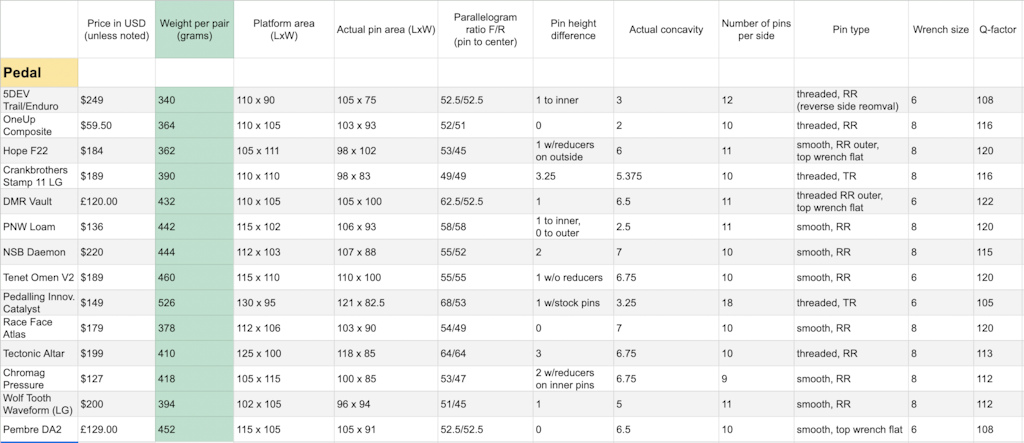
Measurements
One of the most talked about dimensions of flat pedals is how flat they really are. But that doesn’t always make them a sure sell. Thickness isn’t necessarily as important as the concavity, or curve of the pedal.
In this case, we measured from the horizontal across the front and rear pins down to the middle of the pedal body to give a concavity depth. We also recognize that the thickness around the inner and outer edges can be taller than the middle of the pedal body.
The overall length of the pedal can easily outweigh the thickness, in terms of torque forces. Meaning, if they’re thicker, then they probably need to be longer to offset any concerns about keeping your feet from flying off too easily. Like frame geometry, it’s important to look at more than one dimension before making a judgment call.
What about longevity?
Testing the durability of fourteen pedals would take more than a few months, but we did pass these pedals around between friends to expedite wear. Although most were not even close to reaching a rebuild, a couple showed signs of needing love.
Contents
• DMR Vault
• North Shore Billet Daemon
• Wolf Tooth Waveform LG
• PNW Loam
• 5DEV Trail/Enduro
• Pedaling Innovations Catalyst
• Crankbrothers Stamp 7 Large
• Race Face Atlas
• Pembree DA2
• Tectonic Altar V2
• Chromag Pressure
• Tenet Omen V2
• OneUpComposite
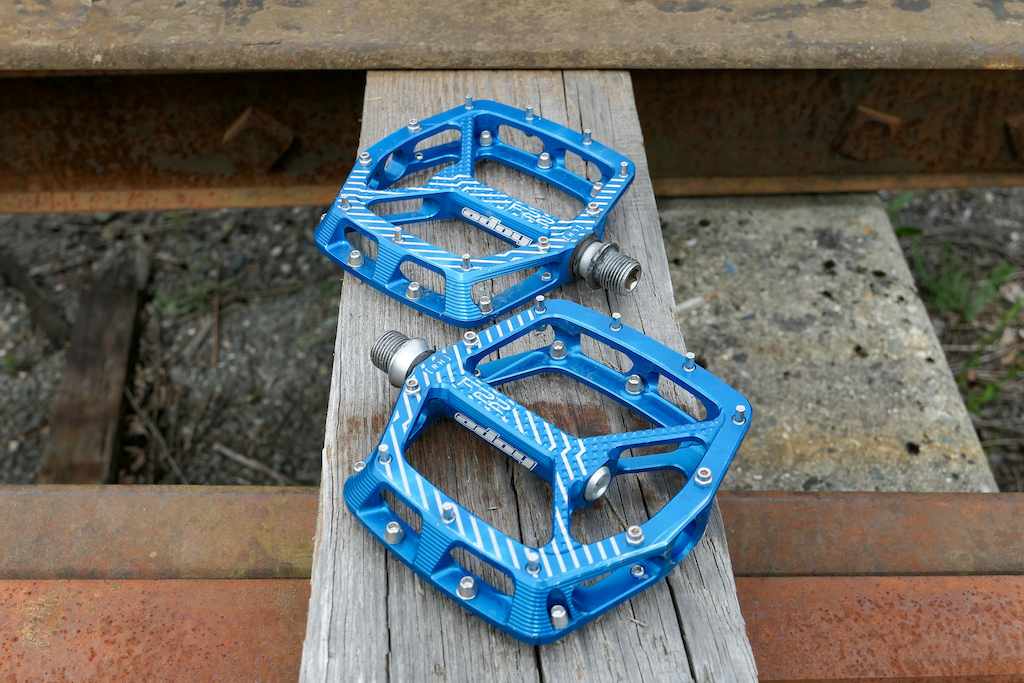
• Pins per side: 11
• Usable platform dimensions (W x L): 105 x 111
• Internals: 3x cartridge bearing + IGUS bushing
• Colors: black, silver, blue, orange, red, purple
• MSRP: $184 USD
• Hopetech.com
Hope Tech churns out CNC’d components in its Barnoldswick, UK, factory for nearly every corner of a bike including their latest F22 flat pedal. The design uses the same internal features of the previous F20 platform, like an IGUS bushing towards the crank arm, and three sealed cartridge bearings but increases the asymmetrical shape. There’s a load of chamfered angles to reduce hanging up on obstacles, pointy pins, and excellent concavity.
Hope ships the pedals without the pins installed, which allows for customization but requires extra patience. Only the pins at the front and rear ends are replaceable from the reverse side.
Although they’re one of the grippiest while descending (and that’s with the pin height reducers installed) I did tend to lose my footing while climbing more often on these pedals compared to the rest of the lot.
My theory is that Hope intended riders to stand further forward on their toes rather than the mid-foot position I naturally gravitate towards. The front-to-rear ratio is one of the largest in the test, and for my foot position that puts too much torque on the front half of the pedal at times, causing my foot to rotate itself off while climbing.
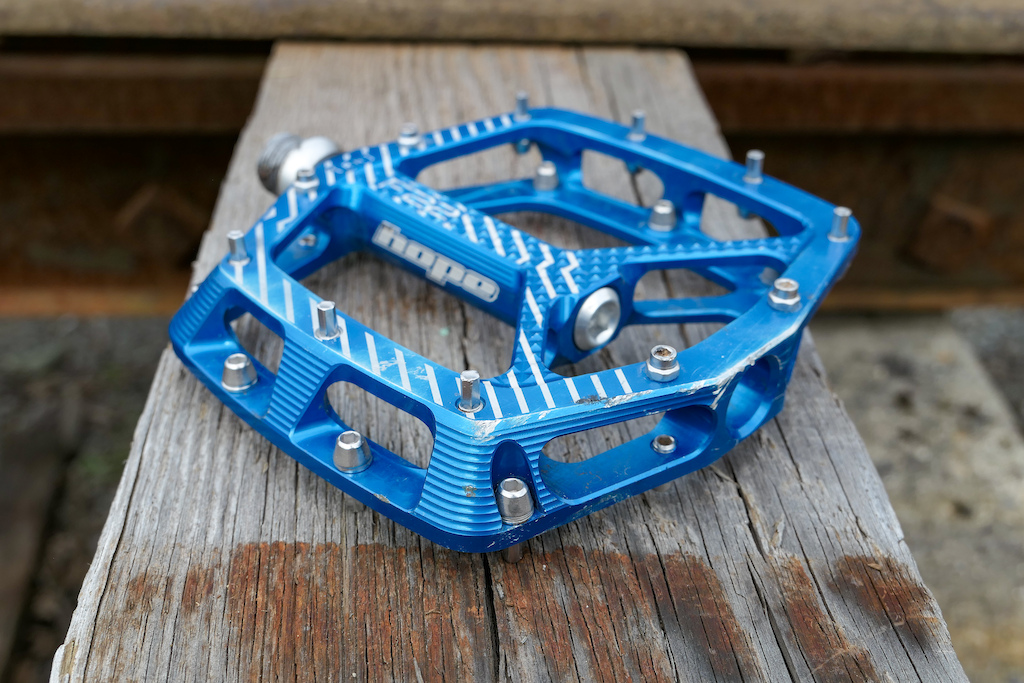

+ Extremely grippy
+ Lots of chamfered edges
+ Pins are easy to tune/change
– Short rear half of pedal is noticeable while climbing
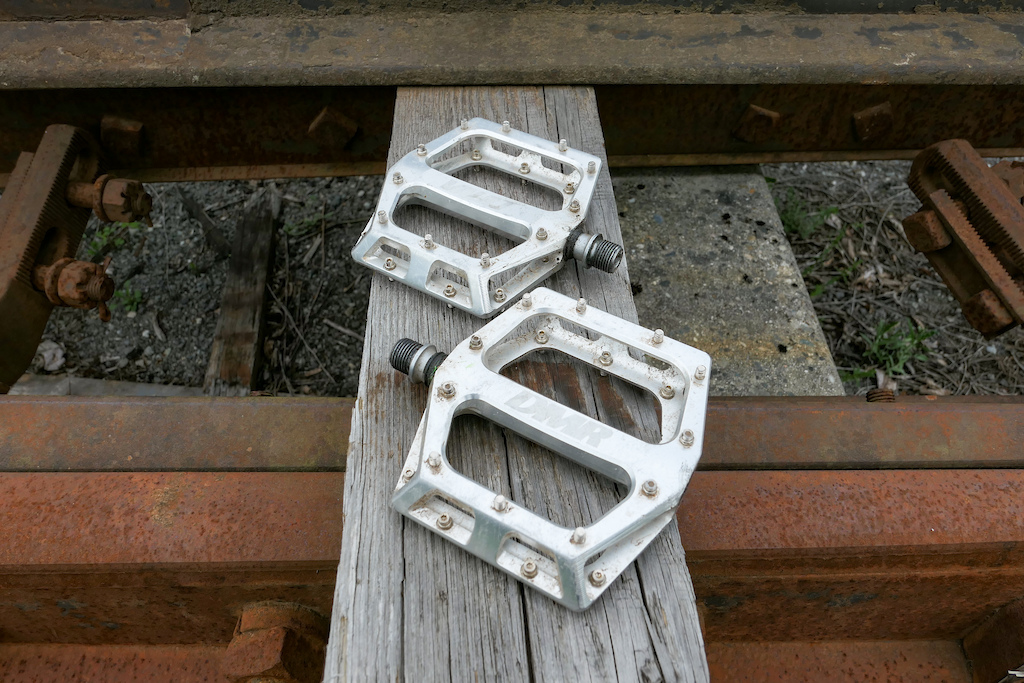
• Weight: 432
• Pins per side: 11
• Usable platform dimensions (W x L): 105 x 105
• Internals: 1x cartridge bearing + IGUS bushing
• Colors: black, silver, blue, orange, red, pink, and more
• MSRP: £120.00
• dmrbikes.com
The Vault has been the go-to choice for flat pedal diehards, like Brendan Fairclough, for years. They balance grip, shape, and weigh in at a reasonable weight and are fairly inexpensive. Their shape is wide, concave, and has plenty of chamfered angles.
In terms of performance under all shoe types, these are the winners for keeping my feet in place. They’re not too concave, which alleviates any foot cramping. For riders with smaller feet, this could change though, as their area is on the large side.
The Vault pedals use two pin types. At the front and rear edges, you’ll find the coveted threaded pins which are conveniently removable from the reverse side.
One downside is that they needed to be re-greased quicker than some others. Changing the DU and bearings is just as straightforward as the competitors though.
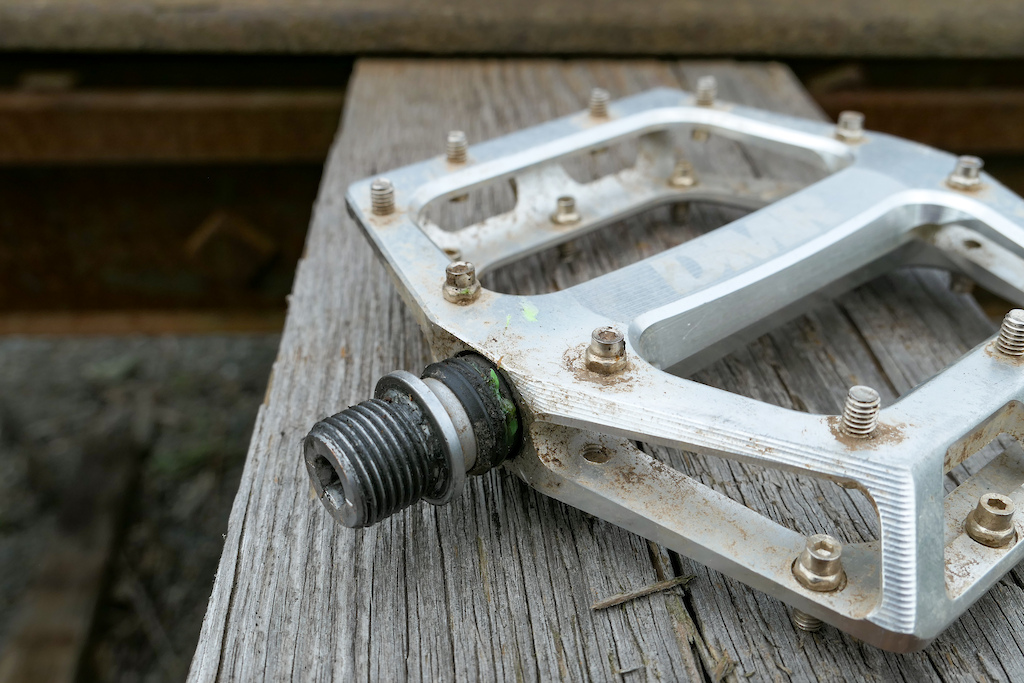
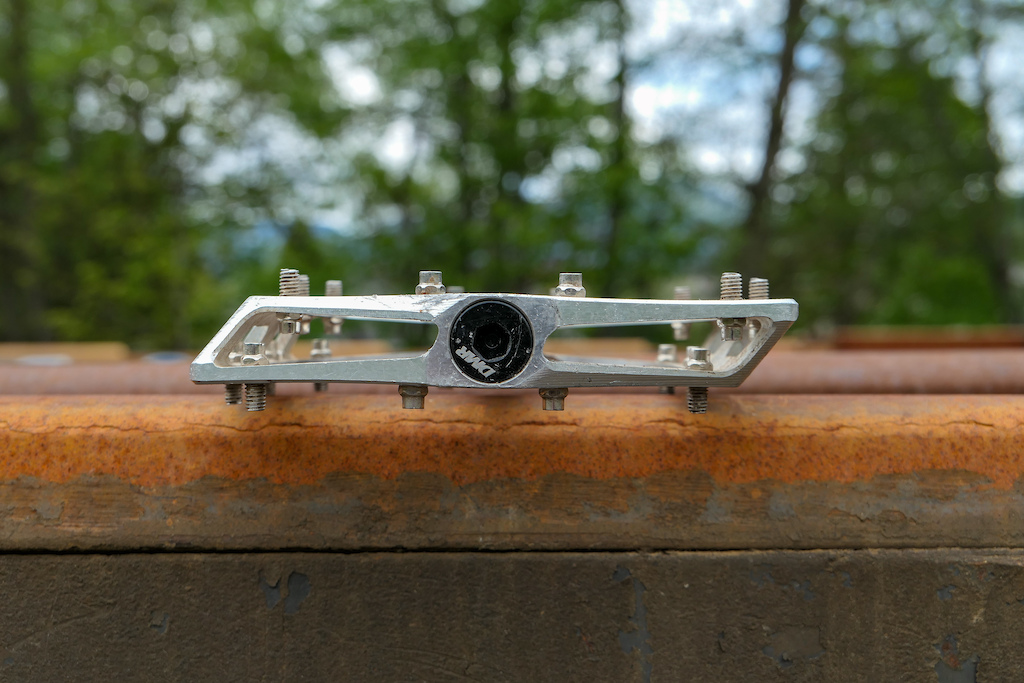
+ Favorite balance of grip and shape
+ Hassle free, threaded pin replacement
– Seals are not as impervious or durable as others

• Pins per side: 11
• Usable platform dimensions (L x W): 112 x 103mm
• Internals: 2x cartridge bearing + IGUS bushing
• Colors: black, silver, pewter, gold, blue, red
• MSRP: $220 USD
• northshorebilletcom
NSB is a Whistler-based manufacturer that specializes in CNC work and makes nearly all of the pieces of the Daemon pedal, even the ten pins on each side. These platforms are longer than most and have a massive amount of material cut out in the middle. The pins are placed away from the axle area to give a serious amount of concavity.
The axle uses a double-sealed steel axle with “VG-style” shaft seal and X-ring. These have multiple sealing surfaces and are less prone to rolling, compared to O-rings. An IGUS bushing is used inboard and then paired with two stainless steel, sealed Enduro cartridge bearings on the outer end.
I love these pedals because of the long dimension and cradle that the concavity forms for your shoe. They are dead easy to relocate your foot on. I did expect slightly more grip out of the pins though, given their puncturing appearance. Adding a threaded style pin, with an option to install reducers, might increase the grip even further and please shoes of all types.
On extended descents with soft-soled shoes, I did find my feet becoming mildly more fatigued. That could be due to my 42-size feet reaching the limit of the lengthy 122mm platform and ultra-deep concavity. Switching to the stiffer Specialized 2FO DH flat pedal shoes helped to relieve that.
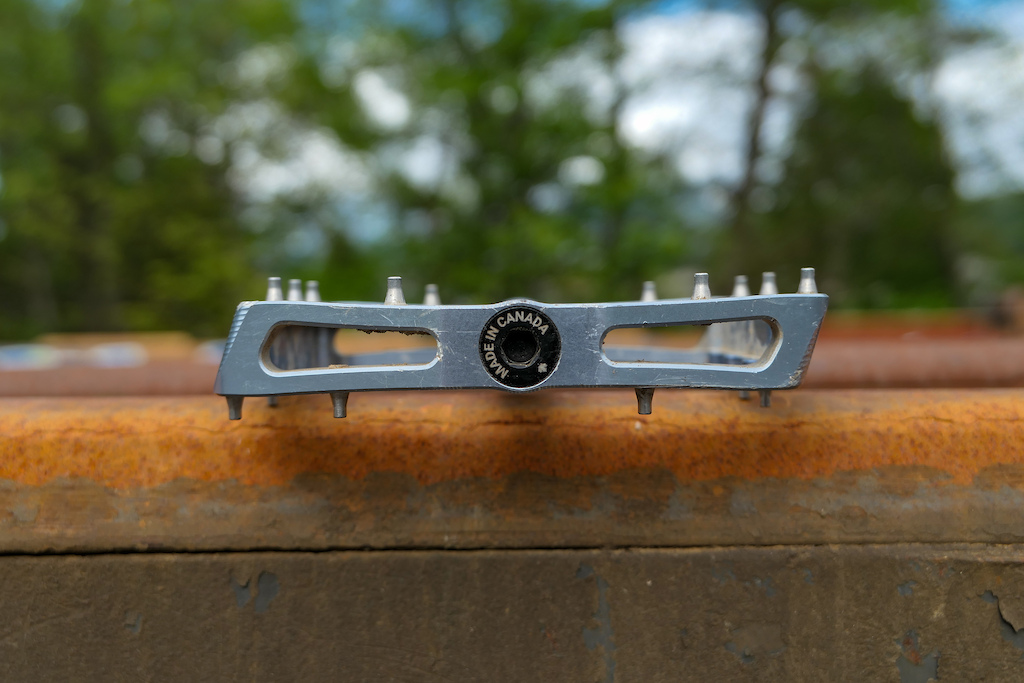
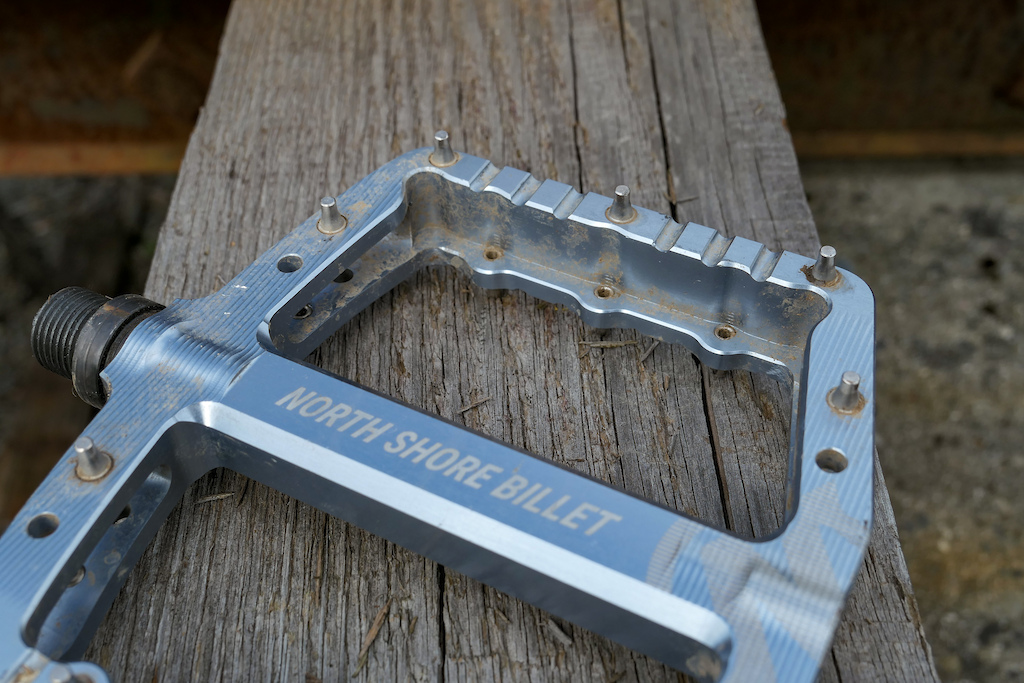
+ Huge platform is easy to relocate foot position
+ Deep concavity
– Small allen head bolt on back of pin jams with dirt
– Pricey
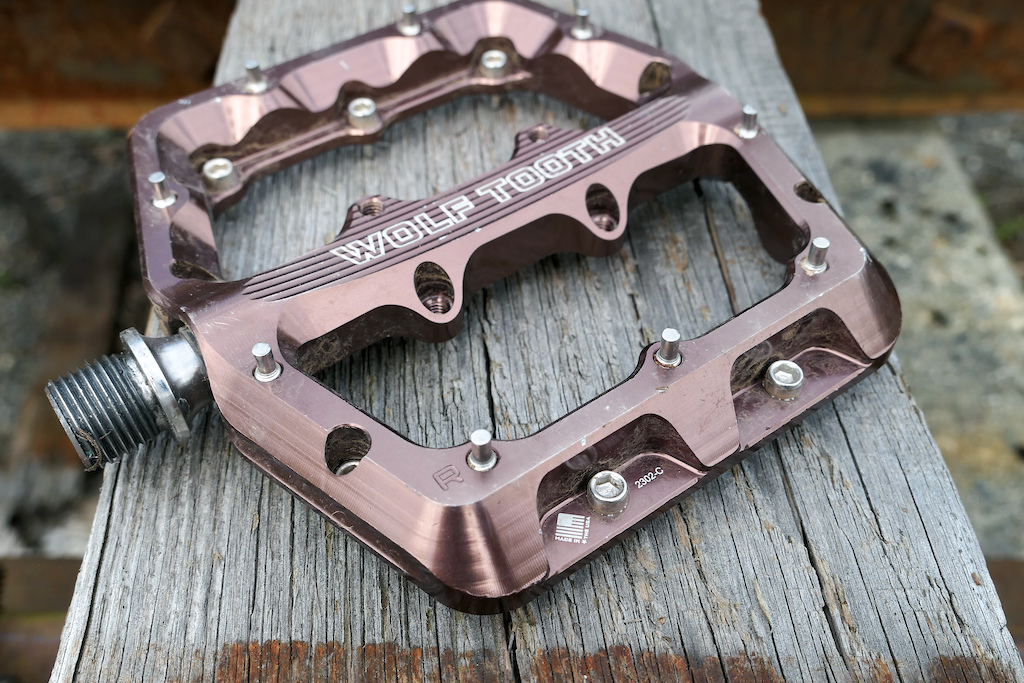
• Pins per side: 11
• Usable platform dimensions (L x W): 112 x 106mm
• Internals: 3x cartridge bearing + IGUS bushing
• Colors: espresso, olive, red, silver, black, blue, orange, and purple
• MSRP: $200 USD
• wolftoothcomponents.com
Wolf Tooth makes a ton of machined parts, everything from chainrings to snazzy handlebar adaptors, but the Waveform is their first take on a pedal. The curvy platforms come in two sizes and a host of colors that match the rest of their parts palette.
We tested the larger 112x106mm Waveforms, whereas the smaller size runs at 105x99mm and knocks off 11g. All of the pins are machined to a sharp, smooth finish and are removable from the opposite side with a 3mm allen key. Six extra pins are included in the box and there is only one height.
The material in the middle of the platform has been reduced in the middle to give a mild dual-concavity, plus there’s ample support close to the crank arm. Even the size large platforms don’t seem over the top in terms of sizing.
Again, a pointier or threaded pin would raise the level of grip, but the shape and feel is spot on. I removed the center pins and found an increased level of grip without any foot fatigue. Overall, the Waveform pedals have a sensible amount of support and grip that provide a “goldilocks” ride.
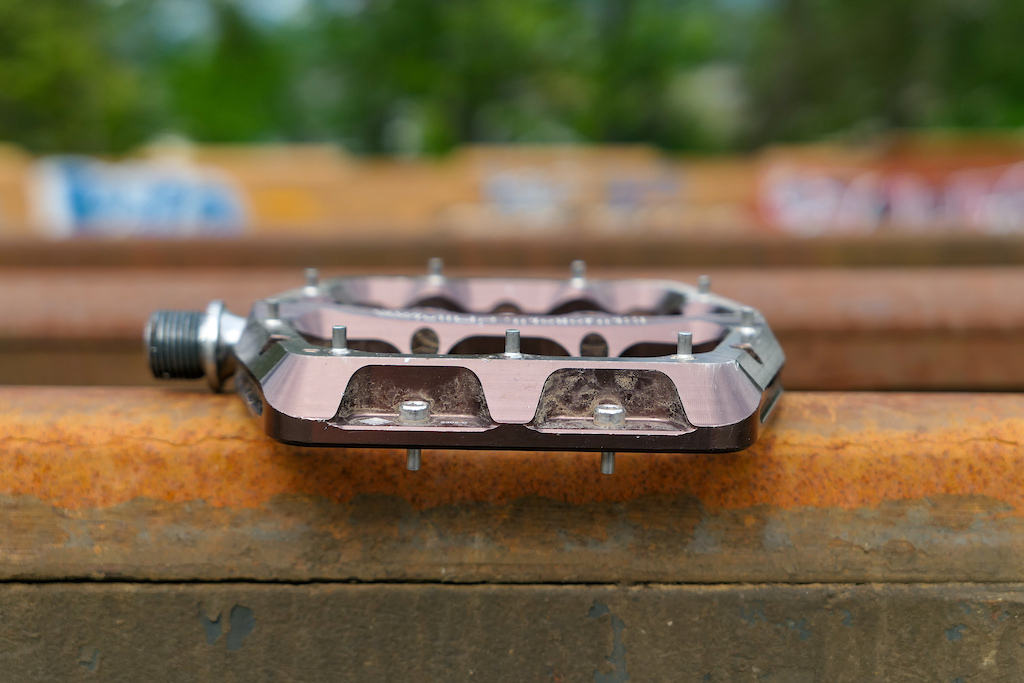
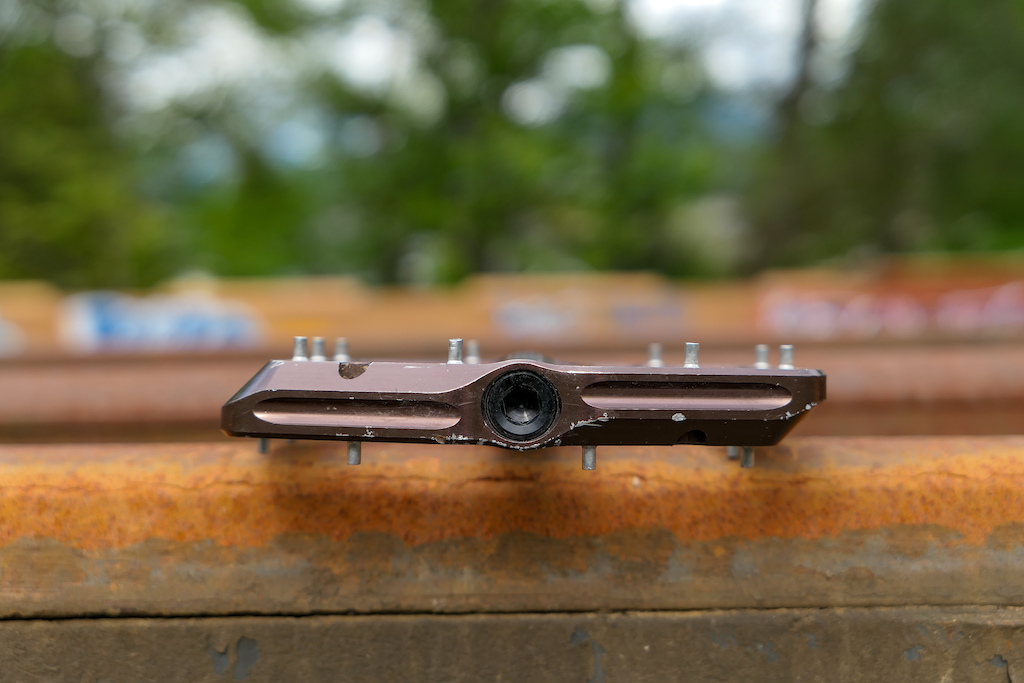
+ Grippy and supportive without going overboard on sizing
+ Platform runs tight to cranks
– A threaded pin option would raise the level of grip
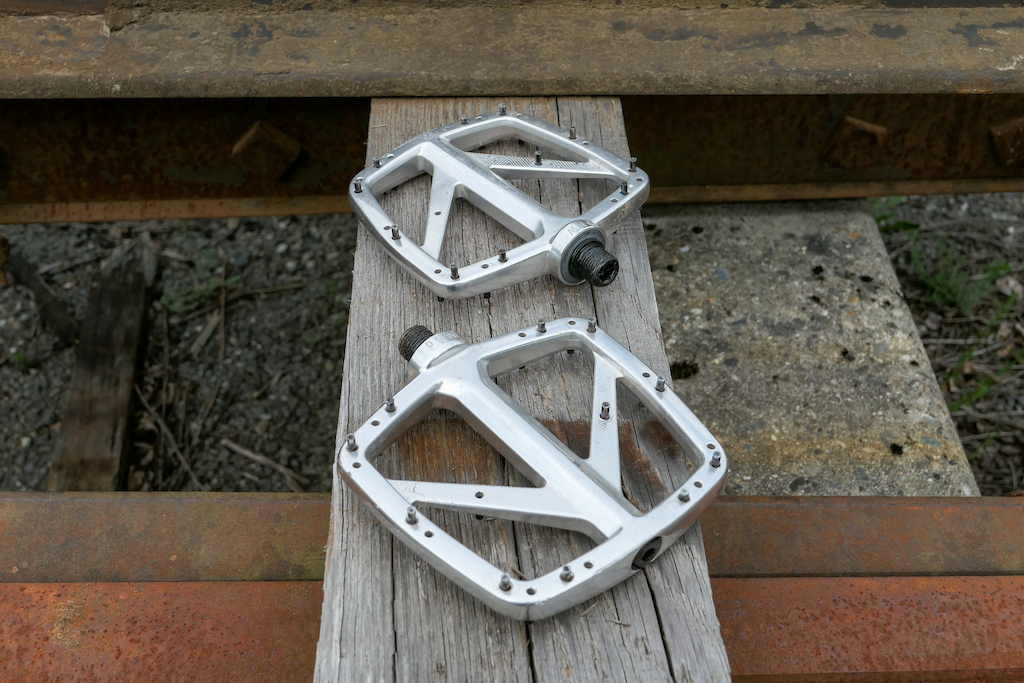
• Pins per side: 11
• Usable platform dimensions (L x W): 115 x 102mm
• Internals: 2x roller bearings (one large inboard), 1x bushing
• Colors: black, silver, purple, orange, green
• MSRP: $136 USD
• pnwcomponents.com
One of the most easily identifiable pedals in the test is the smooth finish, round edges, and angular platform on the Loam pedal from PNW. There’s also an oversize bearing on the inside of the axle and narrower diameter traction pins, like the Race Face Atlas, Canfield Crampon, and OneUp’s alloy option.
I’ll admit, I had some preconceived notions about the Loam pedals in that the angled leading edge would feel strange underfoot and the lack of concavity would cause a few foot slips. Even with a soft-soled shoe, it’s tricky to actually say if I could feel that unorthodox polygon shape.
The inner bearing bulge never caused any major concerns either as I tend to ride duck-footed. Riders who throw tricks where their feet leave the pedals, or position their feet close to the cranks, typically won’t favor this design.
That bearing also started to spin the platform around a bit too quickly for my taste after just a handful of rides. I opened up the internals and found all the bits were in order and clean. Adding thicker grease helped calm this down for another couple of rides.
In terms of grip, I’m of two minds about the Loam pedals. The pins are actually quite impressive, but there’s a lack of concavity to the profile. The front and rear sections of the platform are lower than the center. I thought removing the middle pin would help with this, but that actually pronounced the area over the axle and decreased grip.
Removing the pins should be straightforward since they are accessible from the reverse side, however, the tiny allen key head became clogged with debris soon after the first ride.
It’s worth pointing out that the PNW Loam pedal is the least expensive alloy option in the test. I can’t comment on their long-term durability just yet, but if you’re looking for a pedal that isn’t overly expensive with moderate grip, these could work well.

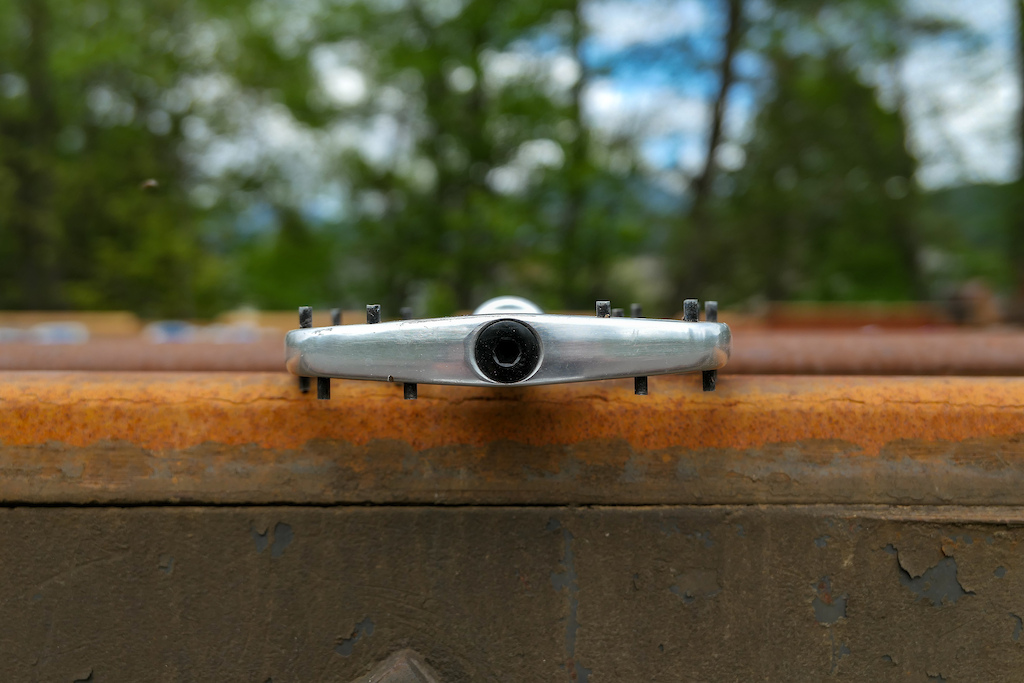
+ Grippier than expected
+ Inexpensive alloy option
– Lacks concavity
– Started to spin rapidly after a few rides
[PSECTION id=5dev]
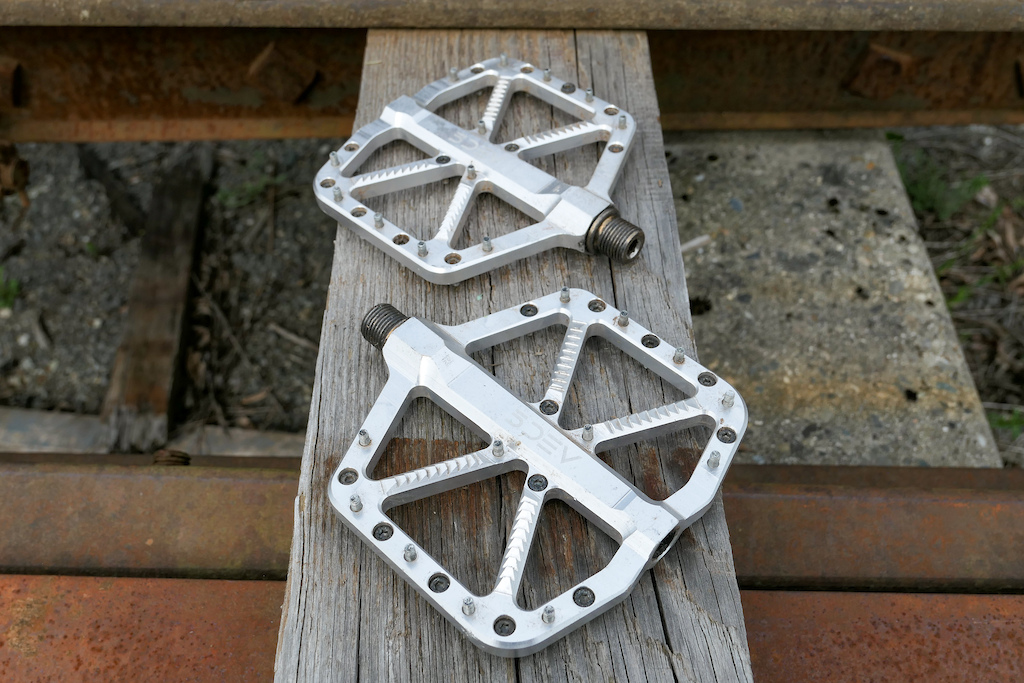
• Pins per side: 12
• Usable platform dimensions (L x W): 110 x 90mm
• Internals: 4x roller bearings, 1x IGUS bushing
• Colors: black, silver, purple, gold, kash
• MSRP: $249 USD
• ride5dev.com
By far the smallest pedals in appearance, but the ones with the sharpest edges, are 5DEV’s Trail/Enduro option. These use the same shape as their All Around pedal but feature two more pins near the center of the platform which are said to increase the traction.
Like the PNW Loam pedals, there isn’t a great deal of concavity because the 5DEVs are very thin overall. They use a 17-4 stainless steel axle which 5DEV claims is 30% stronger than chromoly steel. Two portions of the platform are raised to make way for the four roller bearings and IGUS bushing on the inner end of the axle.
The bushing and axle tolerance also seemed tighter than normal which made the pedal reluctant to stay attached to your shoes, particularly while climbing. Even after a couple of rides, they never broke in so I backed off the axle nut slightly to relieve that friction.
5DEV didn’t design their pedals to have a totally locked-in feel. The sharp, threaded pins grab your shoe quickly without letting them sink too deep into the rubber which gives an interesting hold. Those bumps on the platform do take away from the effective width of the pedal and the concavity though.
Looking at the measurements, the Trail/Enduro pedal is not only small in area and height, but also Q-factor. At 108mm, it’s nearly the narrowest in the test. Personally, I’d trade the clearance for a wider footprint with more support that’s quicker to reposition your foot on. The Trail/Enduro pedals could be a solid option to reduce wide Q-factors on some eMTBs though.
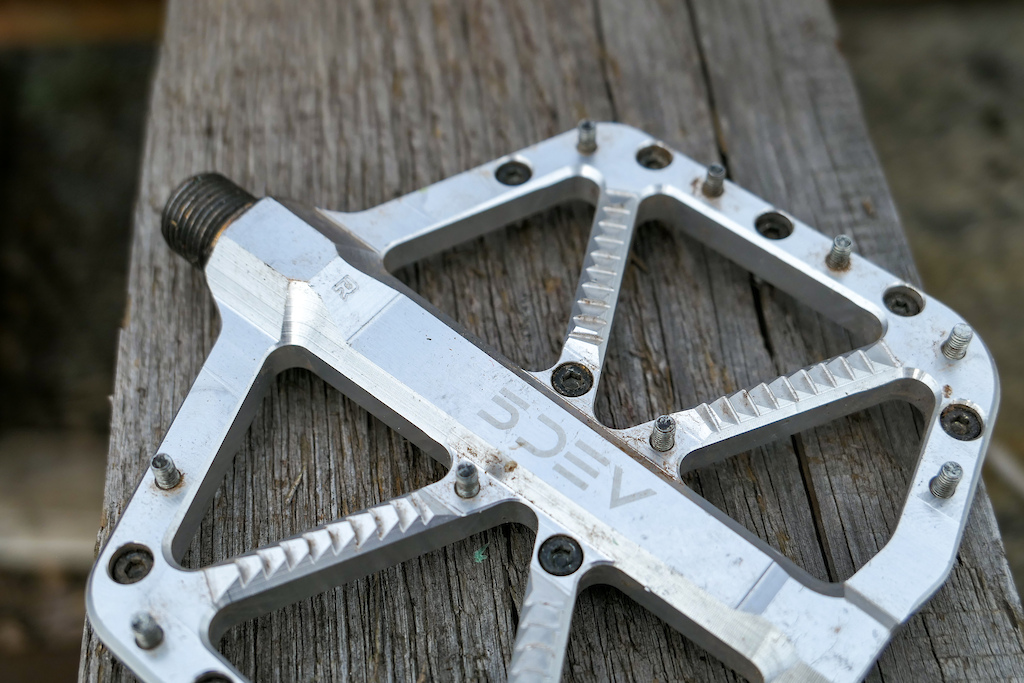
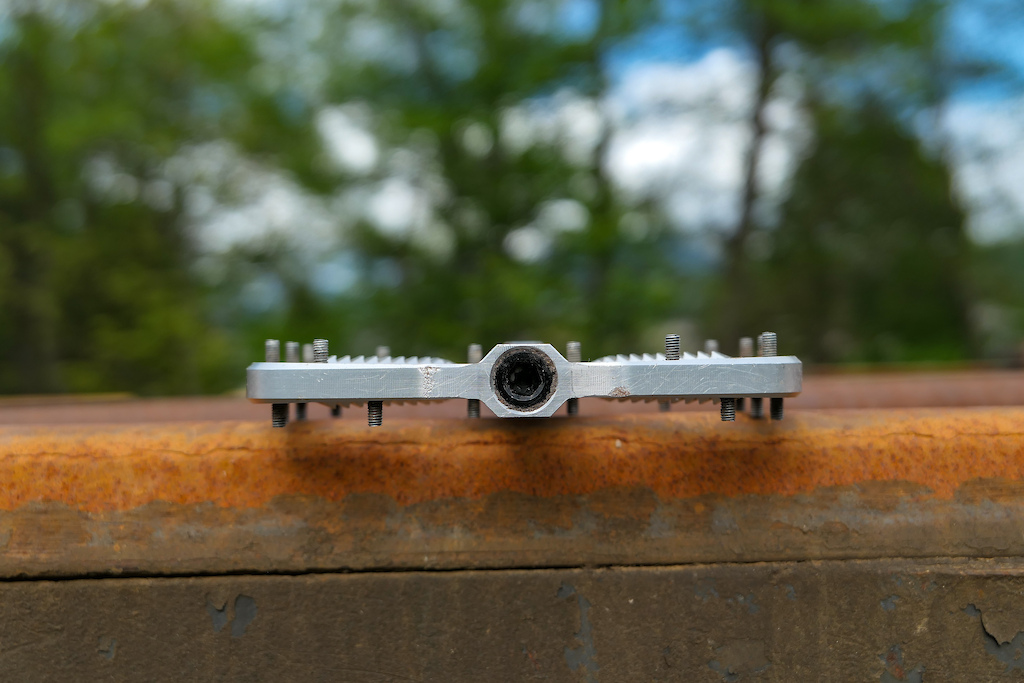
+ Unique balance of light grip without totally locking in
+ Narrow Q-factor might appeal to eMTB riders
– Bushing tolerance is on the tighter side
– Expensive

• Pins per side: 18
• Usable platform dimensions (L x W): 130 x 95
• Internals: 2x roller bearings, 1x bushing
• Colors: black, silver, purple, red, blue
• MSRP: $149 USD
• pedalinginnovations.com
If there’s one pair of pedals that grabs people’s attention, it would be the oversize 130mm long platform of the Catalyst pedals that mountain bike strength coach, James Wilson, founded. The theory behind the massive pedalling platform is to stand with the ball of your foot much further forward, which is shown in studies to deliver more power through your pedal stroke. To back their claims of improved power, stability, and comfort, Pedalling Innovations offers a 30-day money back guarantee on the $149 USD pair of pedals.
While I can say that these monstrous platforms gave me the most confidence in making a connection with my foot placement, I’ll hold off on claiming they improved the specific power delivery. Real-life versus controlled lab results can vary anyhow.
What’s certain though is that there is ample real estate to push down on the pedals. Pedalling Innovations does preface by explaining that your foot needs to be positioned further forward on the Catalyst pedal than traditional types. Finding that spot takes a few rides to adjust to but quickly becomes natural.
For a pedal with such a large platform, the ground clearance is very acceptable because you end up riding with your feet closer to the level of the wheel axles, as opposed to an exaggerated “dropped heels” stance.
The Q-factor is also on the narrow side at 105mm. That didn’t pose as much of an issue as it did on the 5DEV because of the increased length on the Catalyst – there’s an insane amount of purchase to rest on. Pedalling Innovations even makes an XL Catalyst that’s 17mm longer and 10mm wider for size 13 ft and up.
With all eighteen pins per side and the massive surface area, you might think that they’d be the grippiest but I had to install the taller supplied pins for more traction. More concavity from the taller pins helped provide the grip I was looking for.

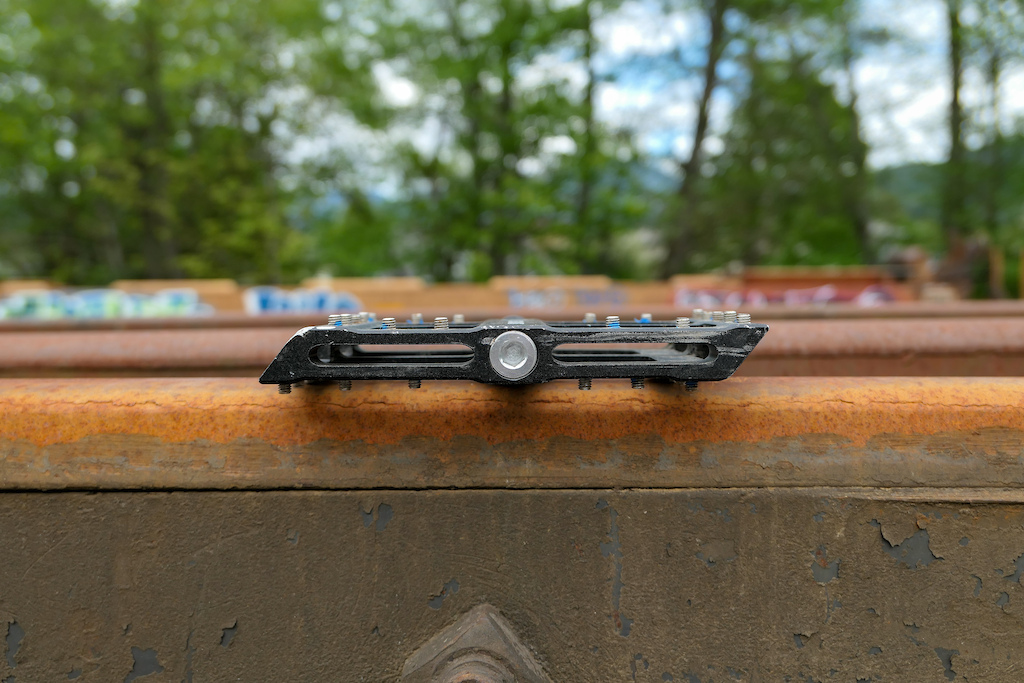
+ Insanely stable footing
+ Doesn’t require rider to “drop their heels” as drastically compared to traditionally sized pedals
– Needs taller outer pins (supplied but difficult and tedious to change)
– Bushings became dry and noisy after a dozen rides
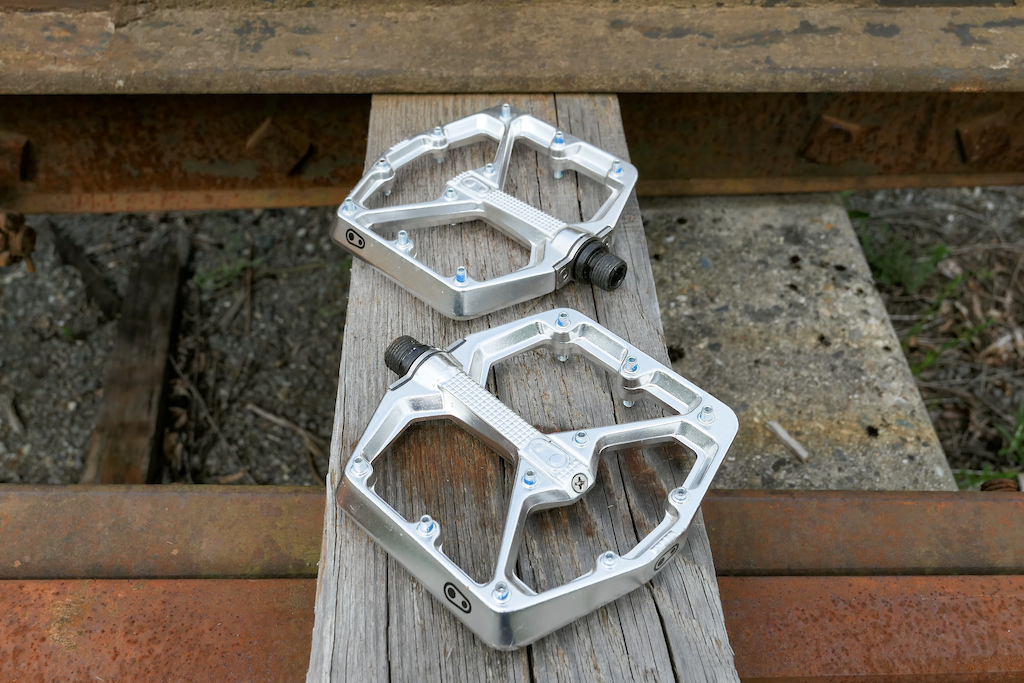
• Pins per side: 10
• Usable platform dimensions (L x W): 114 x 111
• Internals: 2x roller bearings, 1x IGUS bushing
• Colors: black, silver, purple, red, blue, purple
• MSRP: $189 USD
• crankbrothers.com
Simple and effective; that’s the gist of the Crankbrother Stamp 7. These are the larger of the two platform sizes (114×111 vs 100x100mm). There’s also no rider weight limit on either size Stamp 7 which uses a well-chamfered aluminum platform and chromoly axle.
The internals are covered by two different bearing sizes and used in conjunction with an IGUS bushing. At the end of the axle lies a clever grease port capped by a Phillip’s head screw.
To rebuild the pedal entirely, you’ll have to remove it from the crank arm. That’s a minor inconvenience but you won’t even need a socket set to access the internals.
Traditional grub screw pins get my vote for the most traction and that’s all that Stamps use. Those do give up the ease of replacement because these pins aren’t removable from the opposite side of the pedal.
In terms of performance, the Stamp 7 Large pedals are one of my favorites because they balance out all of the qualities I seek in a flat pedal. They’re light, grippy, and have a sufficiently thin frame that doesn’t compromise on concavity, plus the grease port makes them a cinch to regrease.
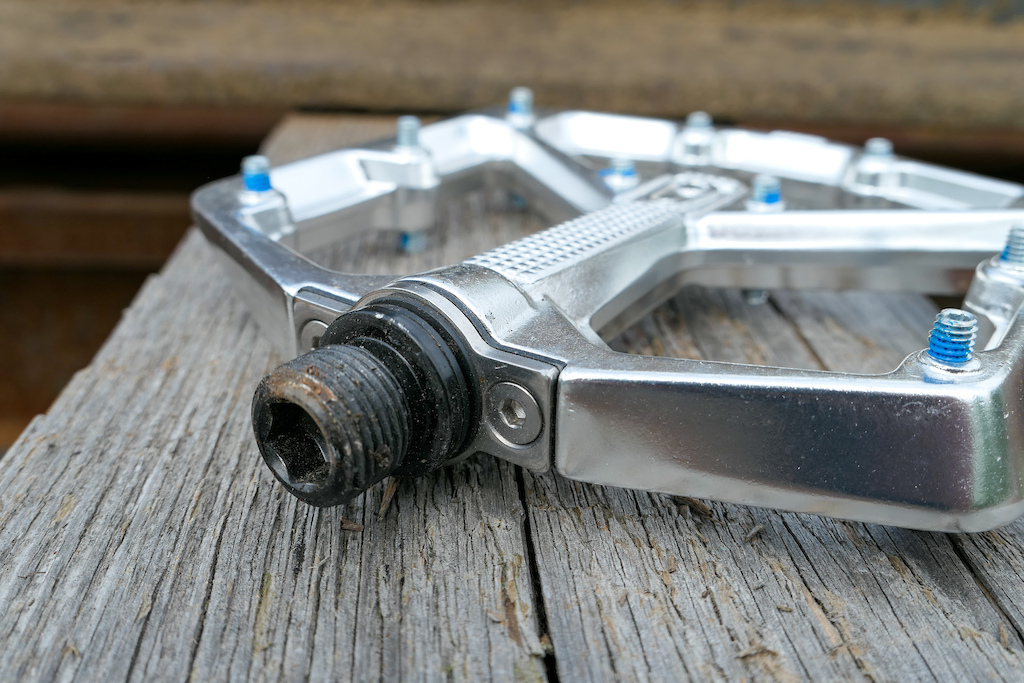
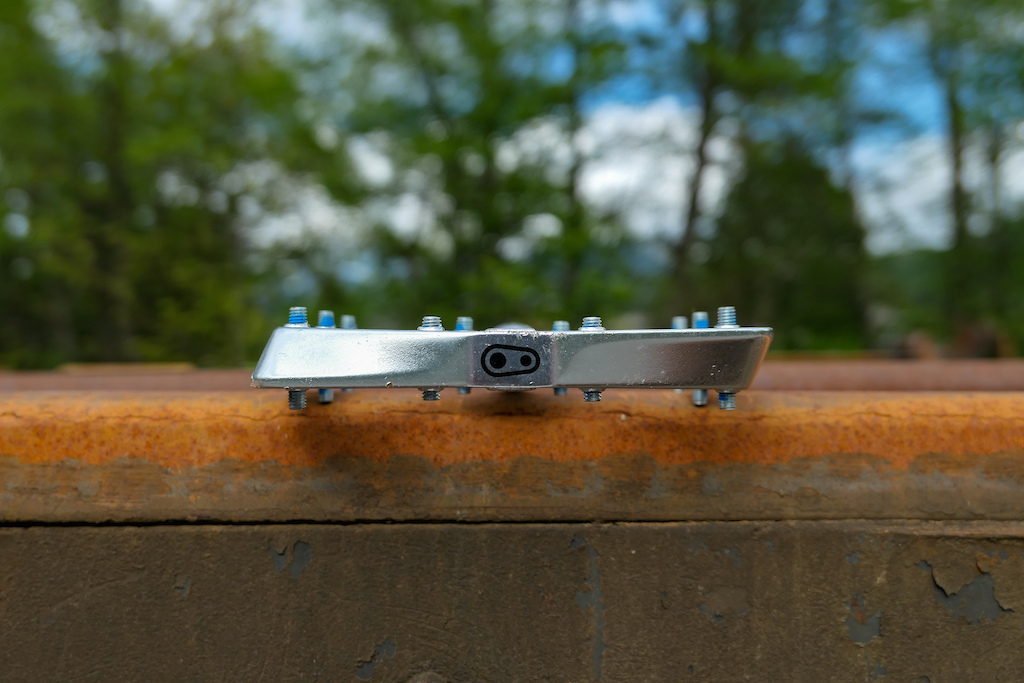
+ Thin and concave
+ Grease port
– Set screw pins are difficult to replace
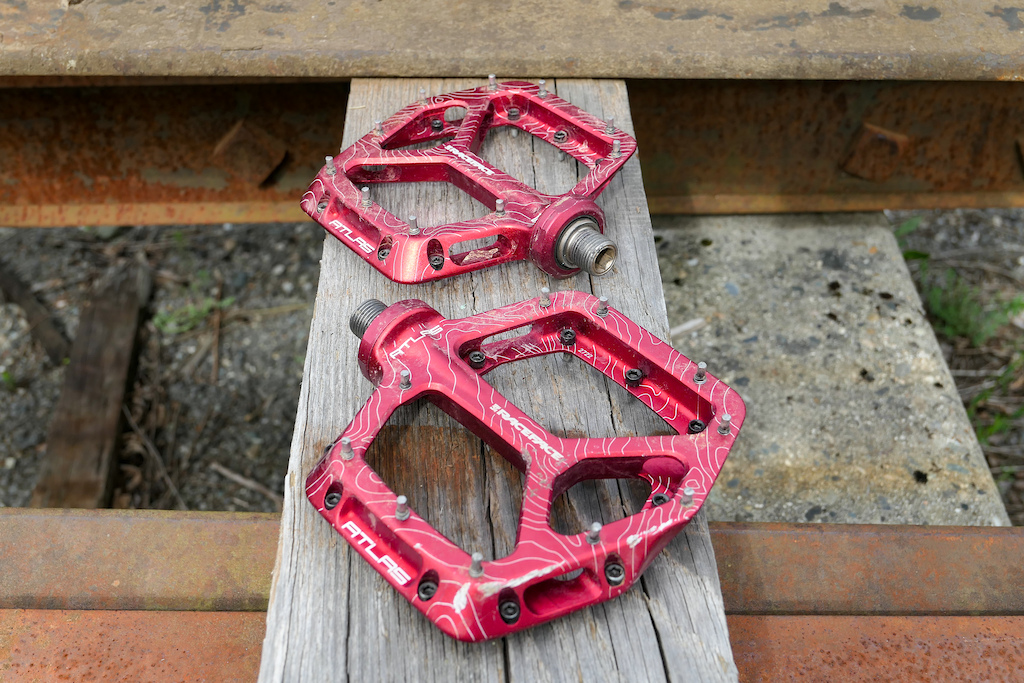
• Pins per side: 10
• Usable platform dimensions (L x W): 112 x 106
• Internals: 1x large roller bearings, 1x bushing
• Colors: black, silver, purple, red, blue, purple
• MSRP: $179 USD
• raceface.com
Another great all-arounder from Race Face is the second generation Atlas pedal with a thin profile, sharp pins, and angular edges. All of the pins load from the reverse side and are of the smooth, needle type. They only use one oversize bearing close to the crank arm and one bushing on the outer end of the axle. By moving the bearing to this location, the platform height is reduced which adds to the stability of the pedal.
The design does mean there is a sizable bump on the inside of the platform for the oversize bearing. Although the platform doesn’t incorporate a noticeable raised bump from the axle itself, some riders will avoid this style of construction due to the bearing bulge that your foot can land on.
Neither the marginally raised center over the axle nor the bearing bump bothered me and I thought that the slim profile and sharp pins of the Atlas edged out the similar construction of the Loam pedals.
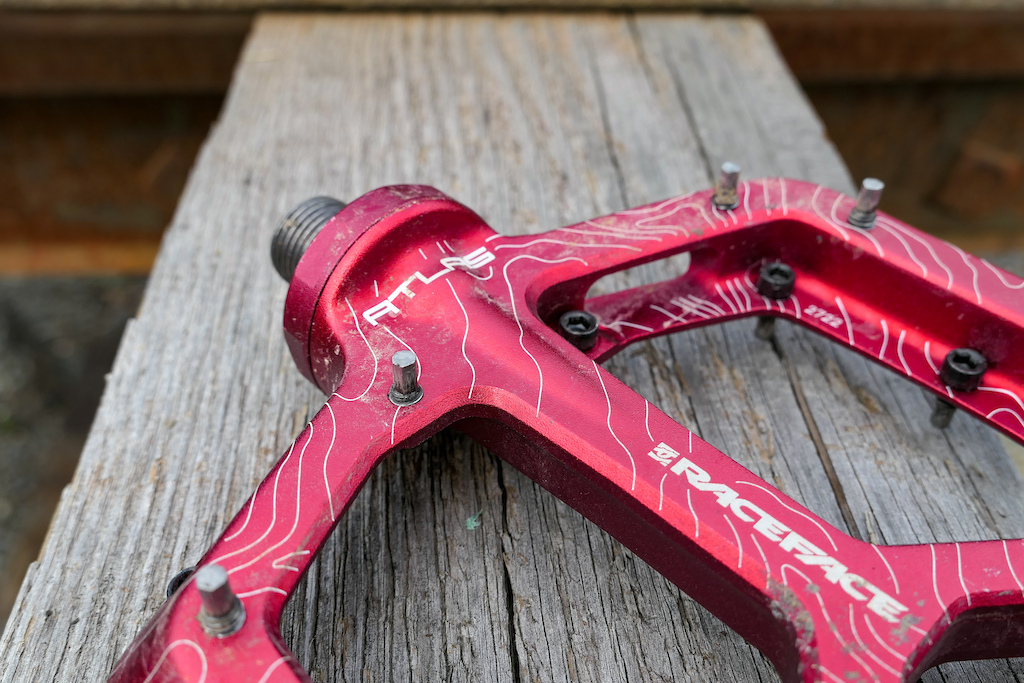
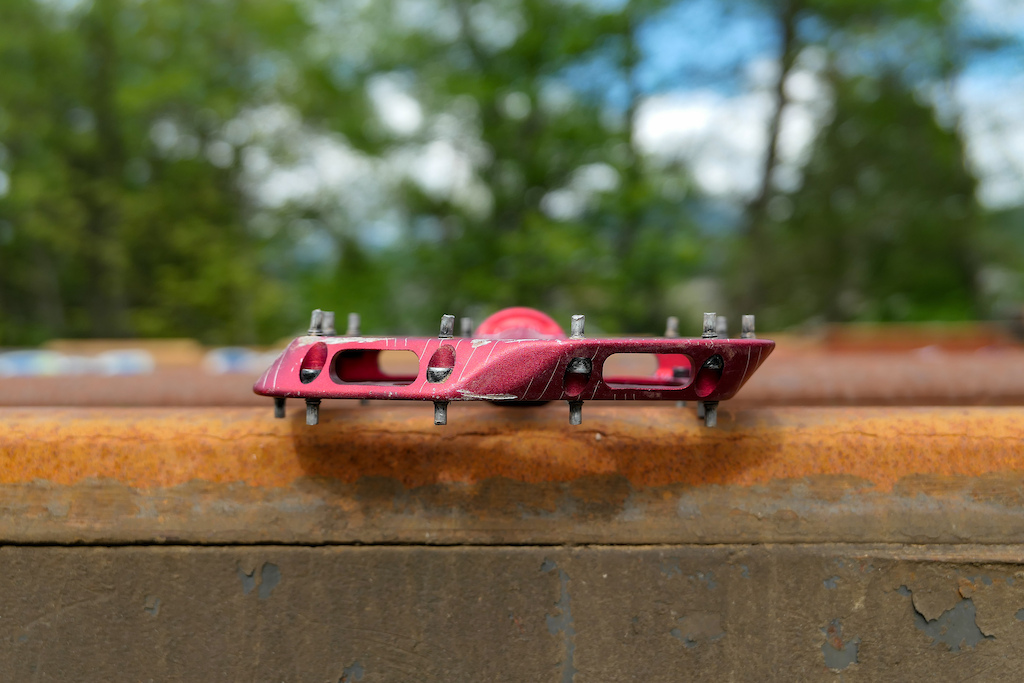
+ Thin without raised axle bump
+ Easy pin replacement
– Bearing bulge doesn’t work for all riders
– Some riders complain about the needle-style pins snapping easily
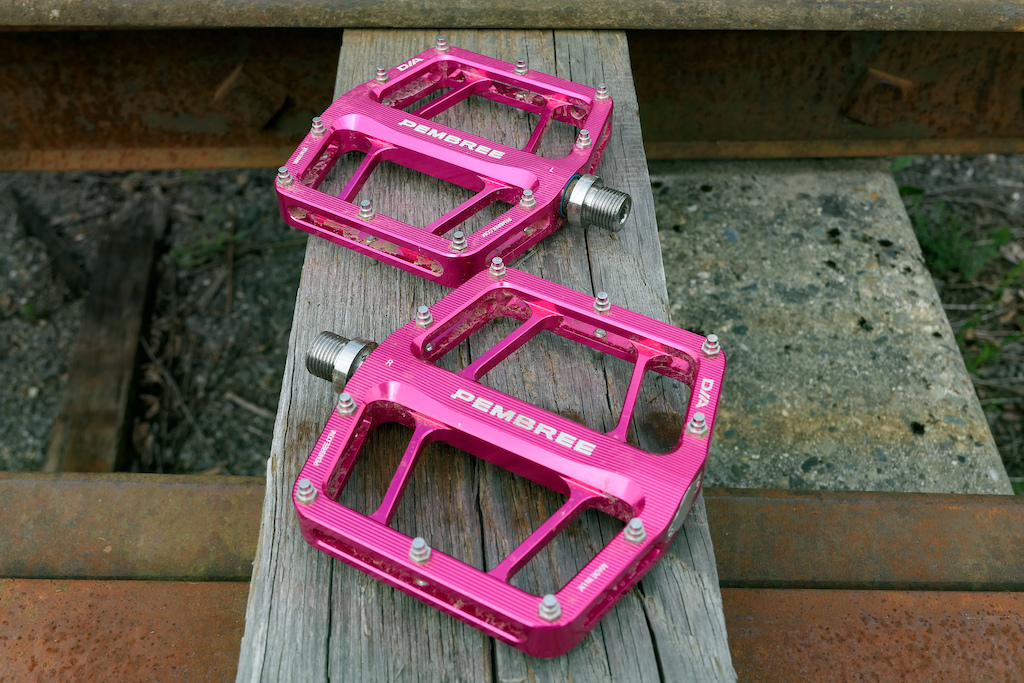
• Pins per side: 10
• Usable platform dimensions (L x W): 115 x 105
• Internals: 2x cartridge bearings, 1x IGUS bushing
• Colors: black, silver, purple, red, blue, purple, pink, orange, bronze
• MSRP: £129.00 GBP
• pembree.com
Pembree’s DA2 pedals are made in Brighton, U.K. and put through the EFBE TRI-TEST for gravity bikes. For a locally made pedal with a highly conscious effort to stay green, the £129.00 DA2 pedals have great value and come in a rainbow of colors.
They’re a tough-wearing pedal with 10 traction pins per side that don’t require special attention to be removed if damaged. The design is straightforward with two cartridge bearings and an Igus bushing.
In terms of support, the DA2s stout platform put them closest to the Tenet Omen V2, although Pembree’s wider-diameter pins don’t bite into the shoe as vigorously. Those pins aren’t quite as tall either, granted, there’s still a decent amount of concavity to match with a long and wide platform area to reclaim solid contact.
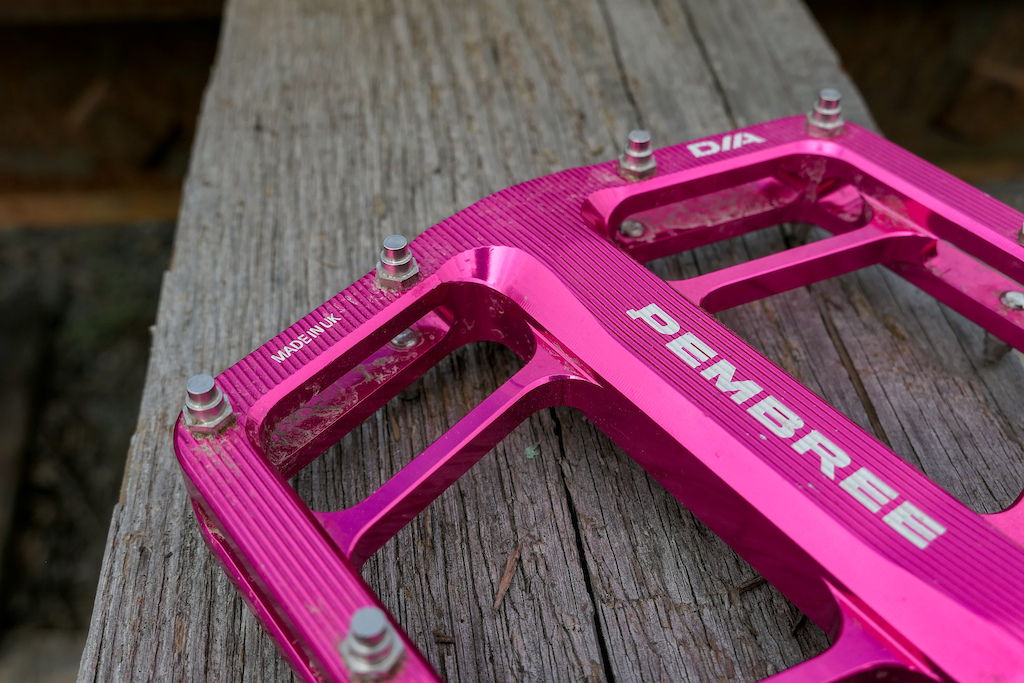

+ Simple design: large, concave, burly platform
+ Easy pin replacement
– Not the grippiest pins
– Thinner options exist
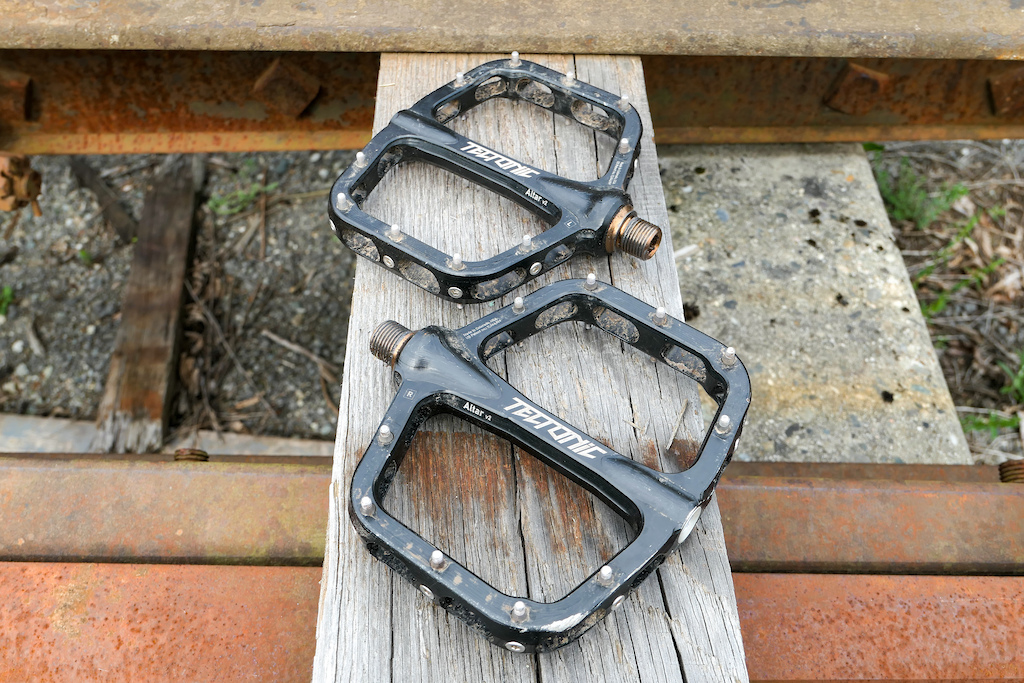
• Pins per side: 10
• Usable platform dimensions (L x W): 115 x 105
• Internals: 2x cartridge bearings, 1x IGUS bushing
• Colors: black, silver, purple
• MSRP: $190 USD
• tectonic.bike.com
New kid on the block, Tectonic, first caught our attention for their carbon composite platform pedal. They’ve since revised the savage-looking Altar pedal to be CNC’d from aluminum in Durango, USA. Their double-ended pins are made from hardened steel that is turned down to a threaded finish held in place by a bolt at the side of the platform.
The internals also differ from the norm by using O-rings and four cartridge bearings, one of which is oversized near the crank arm, instead of a commonly found bushing. Even with the large inboard bearing bulge, there’s still plenty of concavity from the tallest pin down to the middle of the platform. Like the NSB Daemon’s though, that amount of curving from a soft-soled shoe might be too unsupported for some people’s taste.
So far, they’ve seen ample amounts of water and haven’t given up in terms of durability. Between the tall, threaded pins, which are easily replaceable, deep concavity, and mud-shedding capabilities, the Tectonic Altar V2s make it into my top choices.
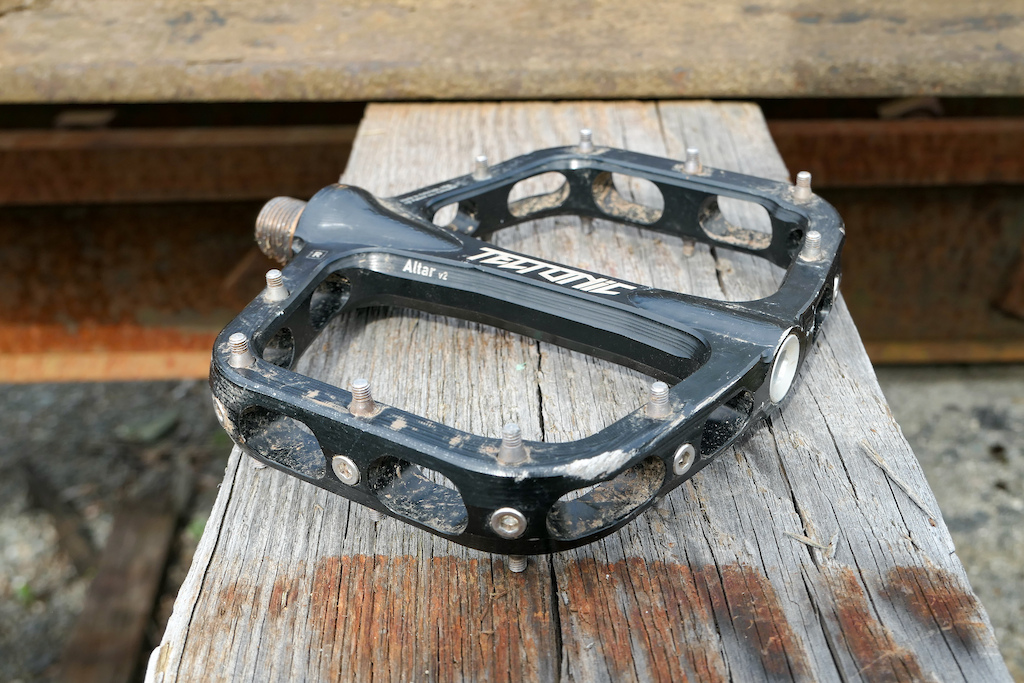
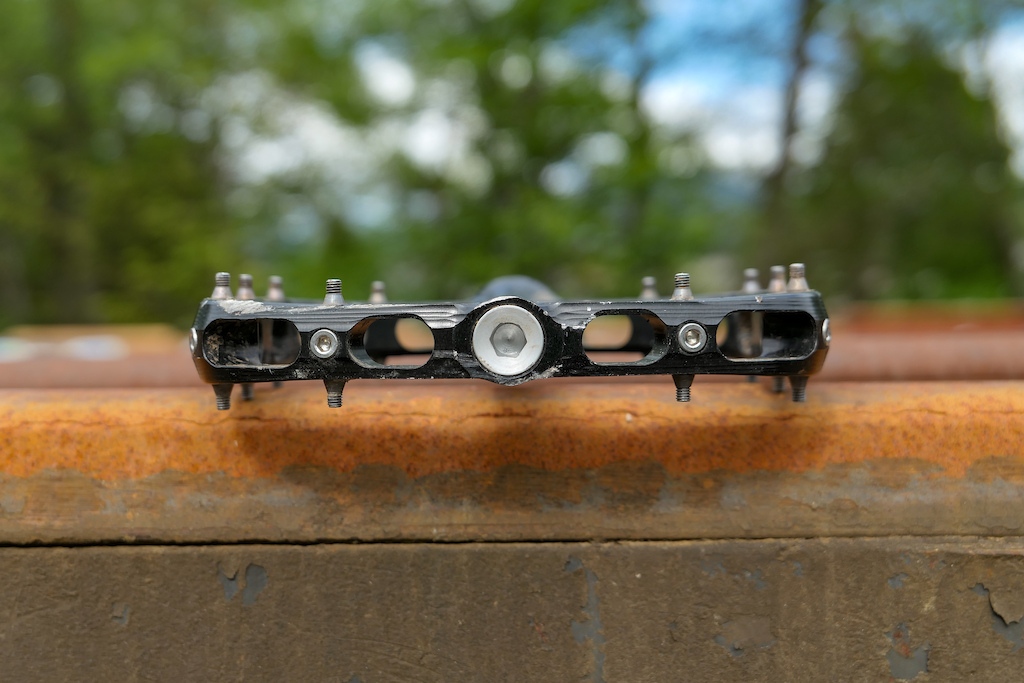
+ Mega grippy threaded pins
+ Huge platform
+ Unique method for replaceming threaded pins
– No option to add middle pins or spacers
– Pins needed to be tightened after first couple of rides
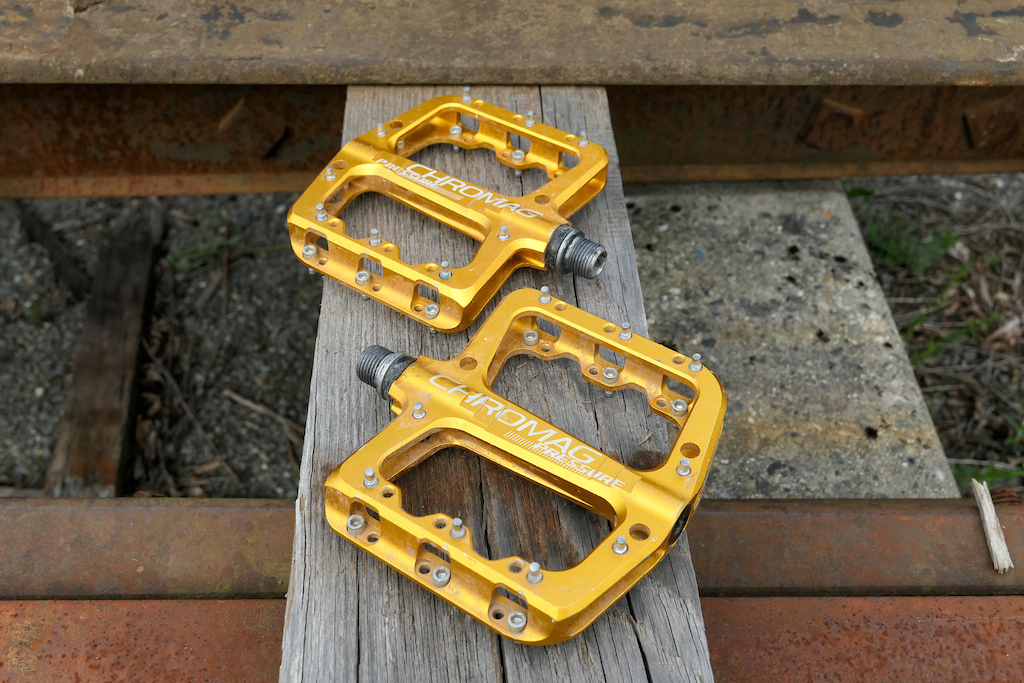
• Pins per side: 9
• Usable platform dimensions (L x W): 115 x 105
• Internals: 1x cartridge bearings, 1x DU bushing
• Colors: black, silver, purple, gold, red, blue
• MSRP: $127 USD
• chromagbikes.com
The Pressure pedal is an update on the popular Contact pedal and carries over favored features amongst freeriders with a platform that wraps in towards the crank arm. That helps the rider to find a solid platform after one-footed maneuvers. The Pressure also has a narrower Q-factor than the Dagga and Scarab pedals.
Chromag’s burly parts have always stood the test of time for me and the axle grease still looks like it came out of the factory. The internal design uses their G3 axle with one bearing and one DU bushing per side.
I removed the front and rear pins on the platform to provide more concavity, which ultimately provided more grip. The spacer system is a clever way to achieve a tuneable feel. I suggest having a drill handy to carefully thread those pins in and out to remove the spacers, otherwise, you’ll spend a solid twenty minutes changing them out.
Removing bent pins might require cutting the damaged portion off first. That’s the trade-off between stronger pins versus those thinner style needles on the Tenet, Race Face, and PNW pedal that tend to sheer off without notice.
Overall, the Pressure pedals are a solid all-arounder. They’re not the grippiest pedals with the round, smooth pins, but that could work for some riders who aren’t looking for fly-trap style pedals. Offering a traction pin with threads to the top of the screw could be a game changer for this otherwise excellent pedal.
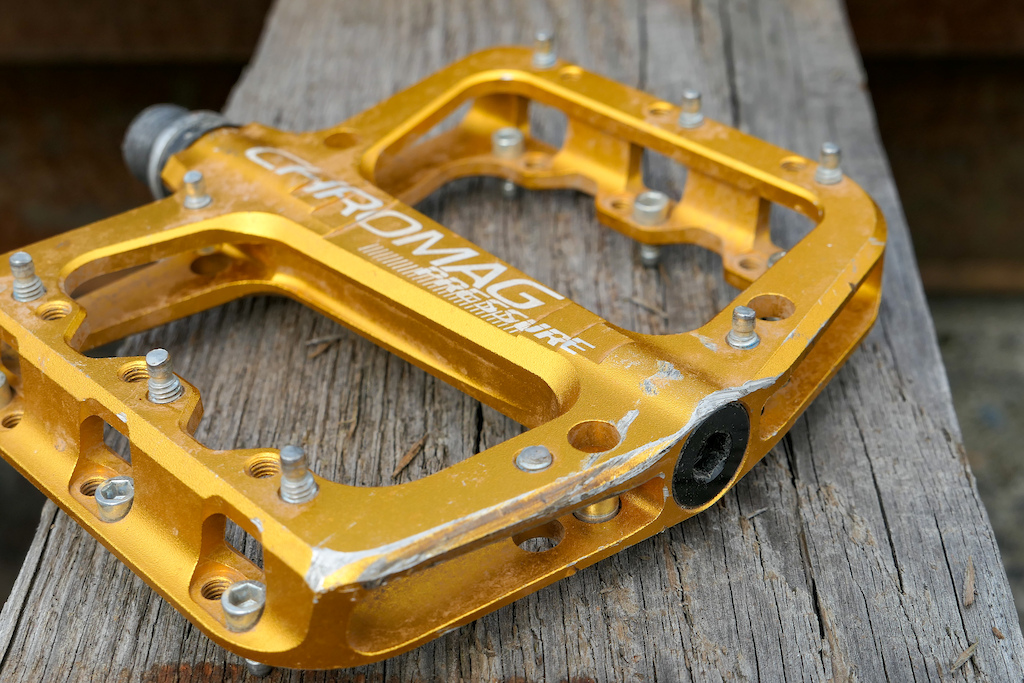

+ Solid performer for the price
+ Body wraps in towards crank arms for solid foot placement
– Threaded-style traction pins would enhance grip

• Pins per side: 10
• Usable platform dimensions (L x W): 115 x 105
• Internals: 3x cartridge bearings, 1x IGUS bushing
• Colors: black, silver, purple, umber
• MSRP: $127 USD
• ridetenet.com
Based in Bellingham, Washington, Tenet Components has evolved their Omen pedal to a second generation with redesigned bearings, seals, and axle for increased workmanship. The Omen V2 is their premium pedal that is made in-house and certified for gravity riding through the EFBE Tri-Test.
Tenet also offers a special service with their Pedal Refresh Program. Customers with pedals that are less than a year old and in need of a rebuild can receive new intervals for just the cost of shipping. After one year, the cost is still minimal at just $30.
On the trail, the massive platform measures in at 115x105mm isn’t the thinnest, but has 2mm of dual concavity which forms a bowl-like shape under the middle of your foot. They’re also the only pedal to offer either smooth or threaded pins, plus washers to adjust the height. I primarily used the smooth, needle-type pins which provided a generous amount of grip. Swapping the pins around the front and rear edges to the threaded pins bumped up the traction even further, making them one of the grippiest pedals in test.
As much as I loved the Omen V2, I did feel like they had less clearance or I bumped them more frequently than the other pedals here. The huge square profile and larger 120mm Q-factor might weigh into that.
For those who are counting grams, their mass shows on the scale too. At 460g, they’re a touch heavier than the huge NSB Daemons, but still roughly 120g lighter than the monstrous Catalysts.
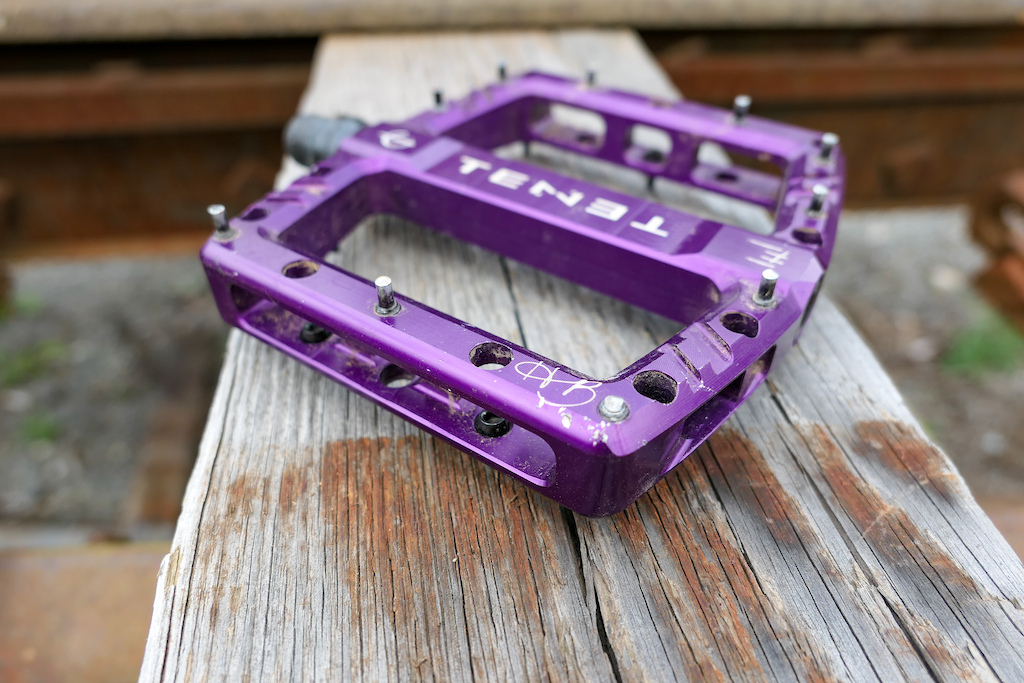
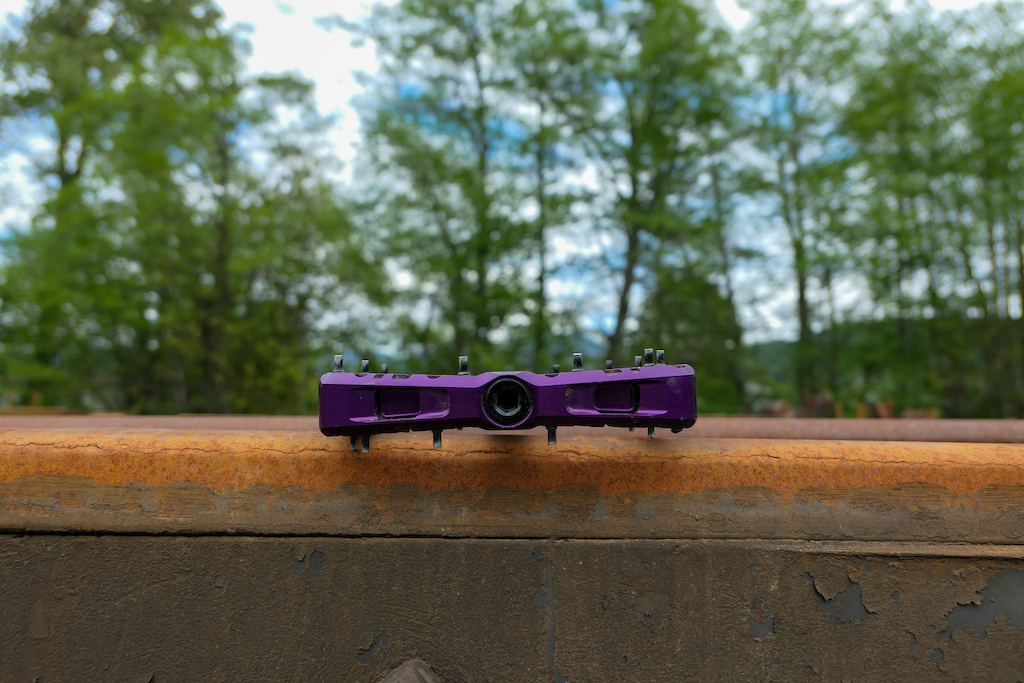
+ Huge area and pins provide solid footing
+ EFBE Tri-Tested
– Some riders complain about smooth pins snapping easily
– Not as slim as others in test
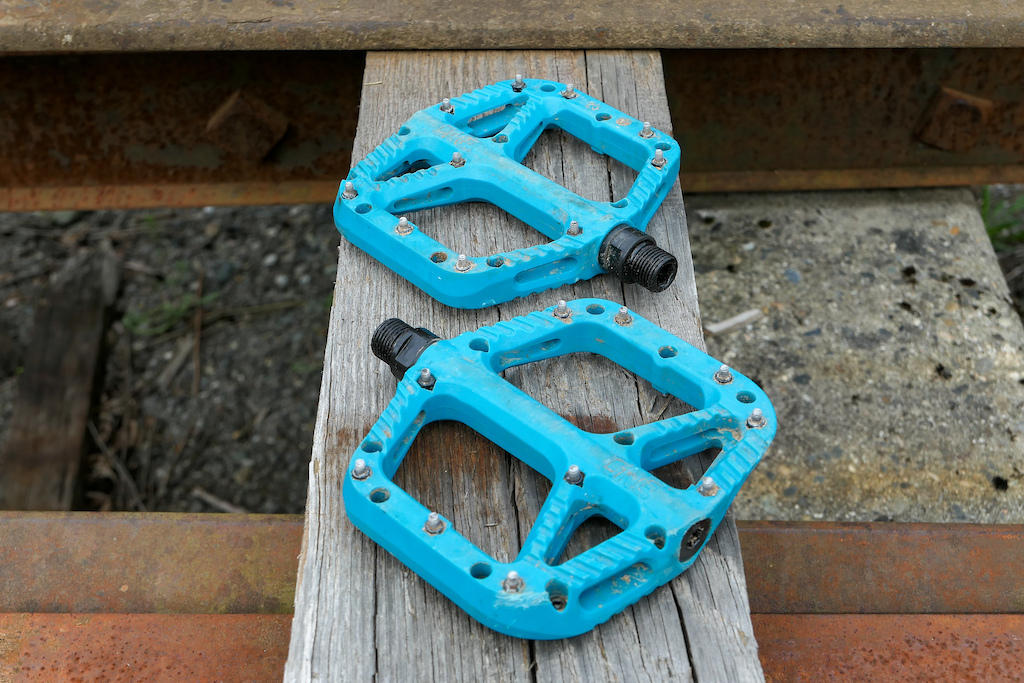
• Pins per side: 10
• Usable platform dimensions (L x W): 115 x 105
• Internals: 1x cartridge bearings, 1x DU bushing
• Colors: black, orange, green, blue, red, purple, turquoise
• MSRP: $59.5 USD
• oneupcomponents.com
Composite pedals spark a hot debate for riders; is it worth investing in an expensive option when options like these OneUp pedals exist? You can still replace the pins and service the internals like any other alloy option – they’re less than half the price. The Composite pedals use a large 115×105 platform and are also available in a smaller size (97.5x92mm) now.
Why are they up against premium alloy competitors? We included their alloy options last time around in a flat pedal group test and thought we’d compare the two.
The Comps offer up to 2mm of concavity from the outer pins to the axle body, whereas their Alloy pedal is virtually zero with a focus on a low-profile platform. The Comps provide a decent amount of grip from threaded, versus the smooth pin-type, and don’t feature the oversize bearing on the inner end of the platform like the Alloys.
I toyed with removing the central pins to increase the concavity but ended up reverting to the stock setup. Without the pins, I could notice that raised section above the axle and thought it reduced the grip marginally.
If you’re a clipless rider who’d like to give flat pedals a shot or think alloy pedals are overpriced, then the OneUp Composites will do the job without breaking the bank. I’m not sold on the idea that composite pedals catch less on rocks or roots, since it’s the pins that usually cause hangups, but to each their own.
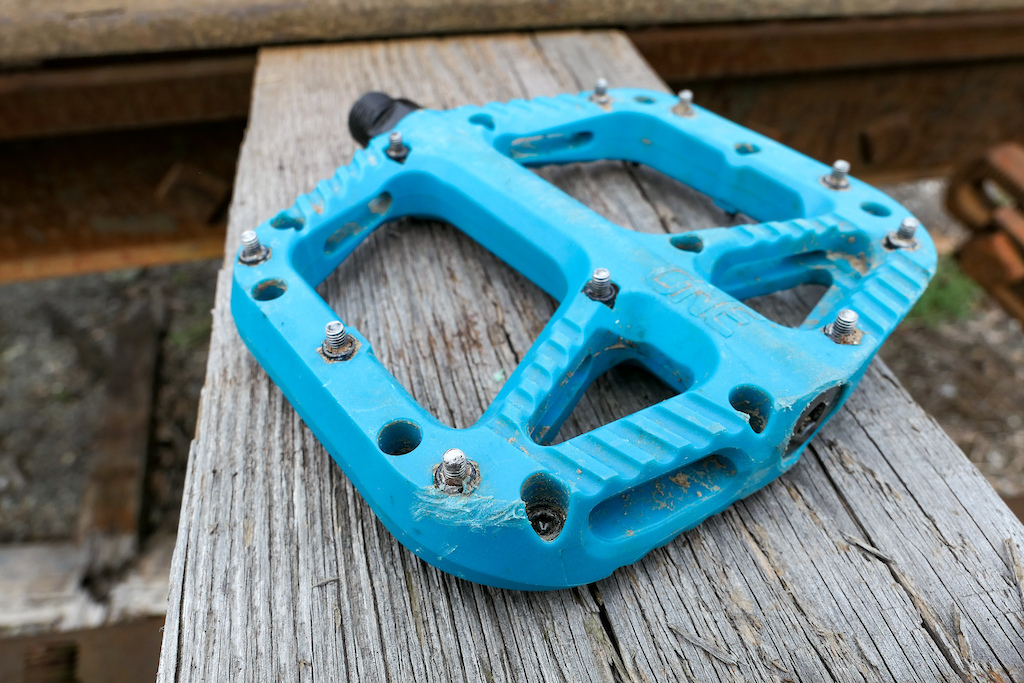
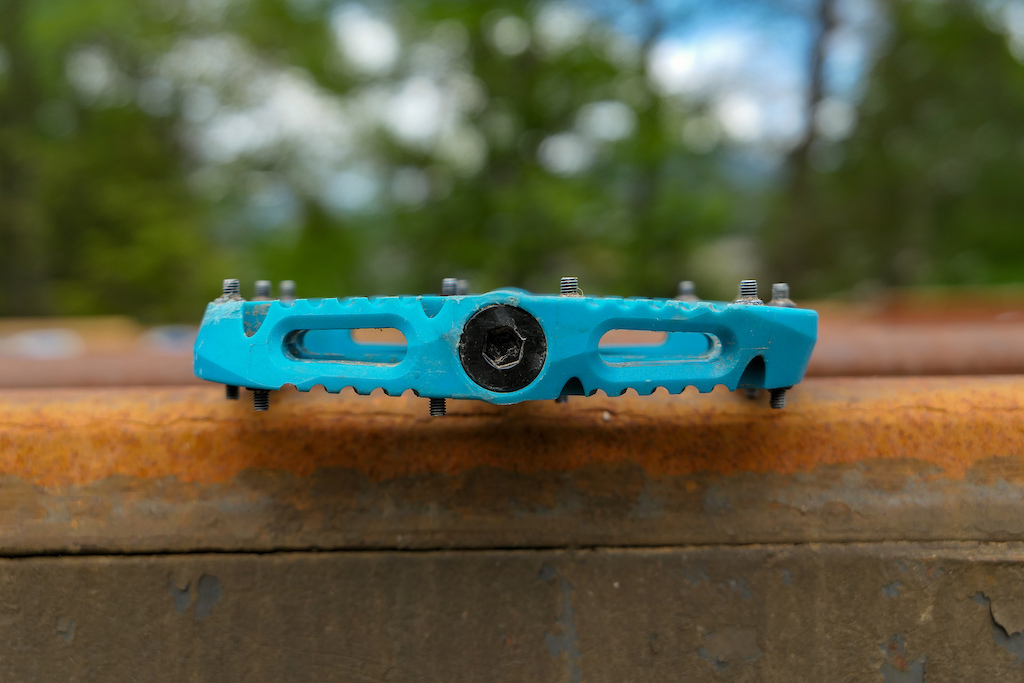
+ Inexpensive
+ Reverse loading, replaceable, threaded pins
– More concavity would increase grip
Wrap Up
That’s a lot of words about metal platforms that propel bikes forwards, so which ones were favorites and why? The most important factor for me has to be concavity. Without this, you need either mega-tall, sharp pins, as I discovered on the PNW Loam pedals – they didn’t have enough concavity in the frame of the pedal and needed the middle pins to reclaim traction.
Secondly, the pin type does make a difference. Hands down, threaded pins are superior. They offer the most grip with their tiny edges that bite into rubber shoe soles, or shins by mistake. Thin, needle-style pins found on the PNW and Race Face pedals work but possibly break with less force and have a touch less hold on the shoe. A solid example of this was seen on the Tenet Omen V2 when we swapped between these two pin types and saw an increase in grip, keeping the pedal body the same.
Other features I’d look for in a quality pedal would be near equal front to rear length on the platform which should better your chance of keeping your feet connected to the pedals while climbing.
Durability is a tricky one to measure. A few pedals with standard DU bushings dried up faster than any with an IGUS bushing. Otherwise, rebuilding any of them isn’t overly complicated or expensive – bonus points for Tenet and their refresh program.
None of the axles bent or pedal bodies were severely damaged. We lost a few pins and some caused more fiddling than others to replace, but otherwise didn’t encounter any other major dilemmas.
Top Picks
Ranking these in a particular order is a tough call when thinking about all of the factors such as grip, durability, overall feel, and value. If I had to pick my top favorites that each stood out in one of those four categories, it would be the Tectonic Altar V2 for all out traction, Tenet Omen V2 for workmanship, Crankbrothers Stamp Large for platform feel, and the DMR Vault for value, not forgetting that they each need to stand up in the other three categories too.
Most Grip
Winner: Tectonic Altar
Runner Up: Tenet Omen V2 (threaded pins installed)
Best Value
Winner: OneUp Composites
Runner Up: Chromag Pressure
Best Overall Feel
Winner: Crankbrothers Stamp Large
Runner Up: DMR Vault
